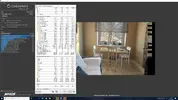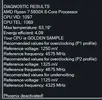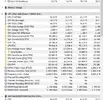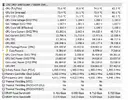pribolo
Utente Èlite
- Messaggi
- 38,481
- Reazioni
- 13,888
- Punteggio
- 253
In realtà se volete ottenere su HwINFO dei valori medi significativi basta avviare HwINFO prima di Cinebench, far partire il rendering e quando il rendering è partito schiacchiare l'orologio in basso a destra su HwINFO, resettando i valori: in questo modo si ottiene una media depurata dagli istanti iniziali.
Oppure si può anche impostare HwINFO perchè faccia la media solo degli ultimi x minuti o secondi, ma questo è un filo meno immediato.
Questa è la mia:

Tra valori medi e massimi in ogni caso cambia poco.
Comunque mi sto rendendo conto che ci sono alcune variabili da considerare:
1) Impostare 1.2v nel BIOS non significa che alla CPU effettivamente arrivino 1.2v sotto carico: per essere precisi bisognerebbe settare la Load Line Calibration fino ad azzerare il vdrop. Nel mio caso in auto il risultato è già ottimo, in altri casi potrebbe esserci più differenza e occorre intervenire manualmente.
Non so se è un dato che vale la pena segnarsi da qualche parte magari
2) La frequenza dell'infinity fabric e la tensione v-soc influenzano il consumo del soc, che entra a far parte del PPT, quindi forse effettivamente la voce "Core Power" è la più significativa
3) La corrente assorbita dipende anche dalla temperatura: maggiore è la temperatura, maggiore sarà il consumo a parità di tensione e frequenza. Ma su questo possiamo farci poco.
Oppure si può anche impostare HwINFO perchè faccia la media solo degli ultimi x minuti o secondi, ma questo è un filo meno immediato.
Questa è la mia:

Tra valori medi e massimi in ogni caso cambia poco.
Comunque mi sto rendendo conto che ci sono alcune variabili da considerare:
1) Impostare 1.2v nel BIOS non significa che alla CPU effettivamente arrivino 1.2v sotto carico: per essere precisi bisognerebbe settare la Load Line Calibration fino ad azzerare il vdrop. Nel mio caso in auto il risultato è già ottimo, in altri casi potrebbe esserci più differenza e occorre intervenire manualmente.
Non so se è un dato che vale la pena segnarsi da qualche parte magari
2) La frequenza dell'infinity fabric e la tensione v-soc influenzano il consumo del soc, che entra a far parte del PPT, quindi forse effettivamente la voce "Core Power" è la più significativa
3) La corrente assorbita dipende anche dalla temperatura: maggiore è la temperatura, maggiore sarà il consumo a parità di tensione e frequenza. Ma su questo possiamo farci poco.
Ultima modifica:



